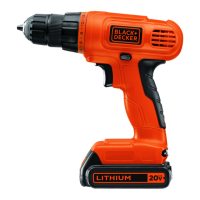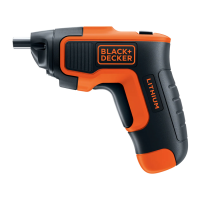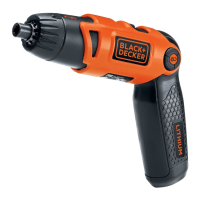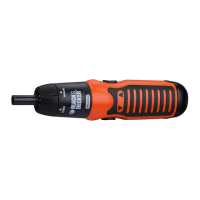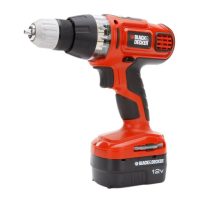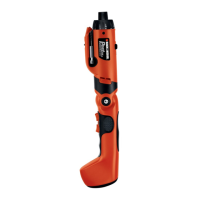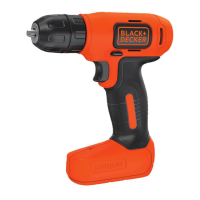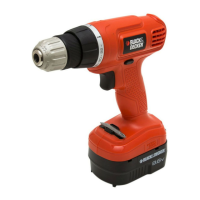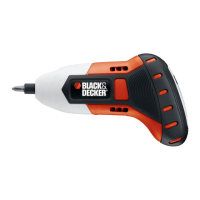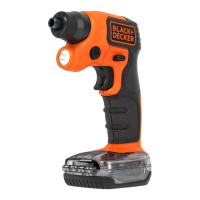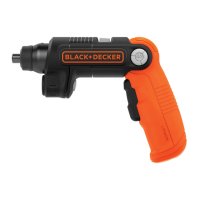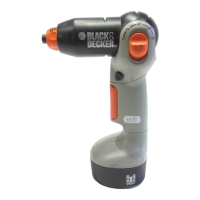ENGLISH
8
On Board Bit Storage (Fig. F)
A bit storage slot
7
is built into the base of the tool.
Mode Selection (Fig. A)
The mode selection collar
3
can be used to select
the correct operating mode depending upon the
plannedapplication.
To select, rotate the collar until the desired symbol aligns
with thearrow.
WARNING: When the mode selection collar is in the
drill position, the drill will not clutch. The drill may stall
if overloaded, causing a suddentwist.
Symbol Mode
Drilling
1-15 Screwdriving (higher number = greater torque)
Trigger Switch/Reversing Button (Fig. A)
1. The drill is turned ON and OFF by pulling and releasing
the trigger switch
1
.
2. A forward/reverse control button
2
determines the
direction of the tool and also serves as a lock off button.
3. To select forward rotation, release the trigger switch and
depress the forward/reverse control button to the left.
4. To select reverse, depress the forward/ reverse control
button the opposite direction.
NOTE: The center position of the control button locks the
tool in the off position. When changing the position of the
control button, be sure the trigger is released.
Proper Hand Position (Fig. A)
WARNING: To reduce the risk of serious personal injury,
ALWAYS use proper hand position as shown.
WARNING: To reduce the risk of serious personal
injury, ALWAYS hold securely in anticipation of a
suddenreaction.
Proper hand position requires one hand on the main
handle
8
and the other hand holding the battery pack
5
.
Installing and Removing the Battery Pack
(Fig.A)
NOTE: For best results, make sure your battery pack is
fullycharged.
To install the battery pack
6
into the tool handle, align the
battery pack with the rails inside the tool’s handle and slide it
into the handle until the battery pack is firmly seated in the
tool and ensure that it does notdisengage.
To remove the battery pack from the tool, press the release
button
5
and firmly pull the battery pack out of the tool
handle. Insert it into the charger as described in the charger
section of thismanual.
OPERATION
WARNING: To reduce the risk of serious personal
injury, turn unit off and remove the battery pack
before making any adjustments or removing/
installing attachments or accessories. An
accidental start‑up can causeinjury.
Performing an Application (Fig.A, E)
WARNING: To reduce the risk of personal
injury, ALWAYS ensure workpiece is anchored or
clampedfirmly.
WARNING: Always wait until the motor has come to
a complete standstill before changing the direction
ofrotation.
Prior to Performing Work
• Install the appropriate bit or accessory into the
chuck. Refer to Installing a Bit or Accessory into a
KeylessChuck.
WARNING:
• Do not use this tool to mix or pump easily
combustible or explosive fluids (benzine,
alcohol,etc.).
• Do not mix or stir flammable liquids
labeledaccordingly.
Screwdriving
Your tool has a clutch with adjustable torque for driving
and removing a wide array of fastener shapes and sizes. The
numbers 1–15 on the mode selection collar
3
are used to
set a torque range for screwdriving. The higher the number
on the collar, the higher the torque and the larger the
fastener which can bedriven.
1. Turn the mode selection collar
3
to the desiredposition.
Refer to Mode Selection.
2. Pull the trigger switch applying pressure in a straight line
with the bit until the fastener is seated at the desired
depth in theworkpiece.
Recommendations for Screwdriving
• Start with lower torque settings, then advance to higher
torque settings to avoid damage to the workpiece
orfastener.
• Make some practice runs in scrap or on unseen areas of
the workpiece to determine the proper position of the
mode selectioncollar.
Drilling
IMPORTANT: For MASONRY, such as brick, cement, cinder
block, etc., use carbide-tipped masonrybits.
1. Turn the mode selection collar
3
to the drillsymbol.
Refer to ModeSelection.
2. Place drill bit in contact with theworkpiece.
NOTE: Use sharp drill bitonly.
3. Pull the trigger switch applying pressure in a straight line
with the bit until it reaches the desireddepth.
WARNING: Drill may stall if overloaded causing a
sudden twist. Always expect the stall. Grip the drill
firmly to control the twisting action and avoidinjury.
4. Keep the motor running when pulling the bit back out of
a drilled hole to preventjamming.
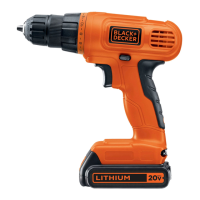
